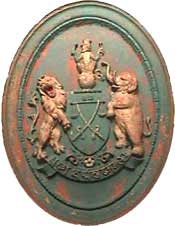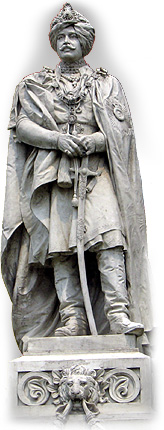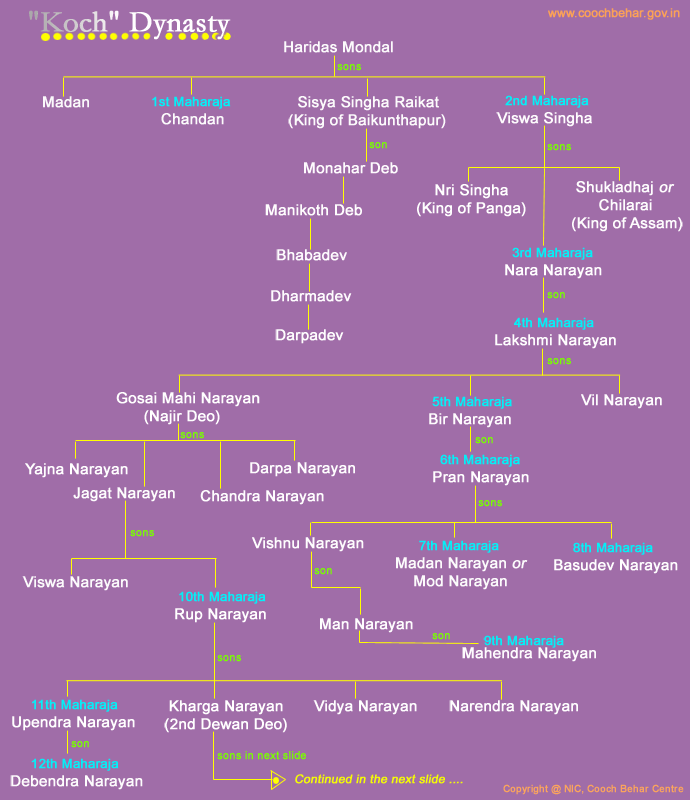 The early history of Cooch Behar has to be sought in the history of Assam. In early times the territory was known as Pragjyotisha, which is mentioned in the Ramayana and the Mahabharata. It appears that the western part of the original territory of Pragjyotisha came to be known as Kamarupa in later times. Kamarupa remained under the suzerainty of the Guptas and Palas for some time. According to tradition, Kamarupa was conquered by Muslim Army in A.D.1498, but they could not keep the kingdom for long. After the expulsion of the Muslim army, the Kamta kingdom was engulfed in anarchy. During that period, the rise of Koch king started.
The early history of Cooch Behar has to be sought in the history of Assam. In early times the territory was known as Pragjyotisha, which is mentioned in the Ramayana and the Mahabharata. It appears that the western part of the original territory of Pragjyotisha came to be known as Kamarupa in later times. Kamarupa remained under the suzerainty of the Guptas and Palas for some time. According to tradition, Kamarupa was conquered by Muslim Army in A.D.1498, but they could not keep the kingdom for long. After the expulsion of the Muslim army, the Kamta kingdom was engulfed in anarchy. During that period, the rise of Koch king started.

Maharaja Nripendra Narayan
(in front of District Court,
Sagar Dighi Campus)
The king Viswasimha assumed the title of Kamteshwar. He died in about 1533 and was succeeded by his second son Naranarayan, who was also known asMallanarayan, after a civil war with Nar Singh who fled to Morung and then to Bhutan. Narnarayan died in 1584 and was succeeded by his son Lakshminarayan who died in 1627. Lakshminarayan was succeeded by his son Birnarayan. In his later years, he had appointed one of his sons Mahinarayan to be Nazir- deo. Birnarayan died in 1632 and was succeeded by his son Prannarayan who reigned till 1666. He constructed or repaired the temple of Baneshwar. Modnarayan succeeded his father. From his reign, the influence of Bhutan on Cooch Behar started. He died in 1680 without a male heir. In that situationVasudevnarayan, the third son of Prannarayan was placed on the throne. He was killed in a skirmish. Then, Mahindranarayan, the great- grandson of Prannarayan was placed on the throne. With the death of Mahindranarayan, Rupnarayan came into the power. After a reign of 21 years, he died in 1714. His son, Upendranarayan remained till 1763. The boyDevendranarayan was installed as king under the guardianship of Nazir Lalitnarayan. In 1765 Dhairyendranarayan, the son of Kharganarayan (brother of Upendranarayan) was placed on the throne. The influence of the Bhutias had increased so much that an office of Bhutan was permanently stationed at Cooch Behar with an army. In later years he was kept in confinement by the Bhutan. His son Dharendranarayan was installed on the throne. The East Company was watching with concern the growing power of Bhutias close to their borders. The appeal for help by Nazir was admitted by the company. On April 5, 1773, the treaty between the young Maharaja Dharendranarayan and the East India Company was finalized. Thereafter a peace was concluded between Bhutan and East India Company on April 25, 1774, in consequences of which Dhairyendranarayan was released from captivity. Dharendranarayan died in 1775 and thereafter Dhairyendranarayan took over the second time. He died in 1780, leaving his only heir Harendranarayan. Narendranarayan succeeded him after his death. In 1859 a topographical survey of Cooch Behar was made byJ.G.Pemberton. Nripendranarayan (one year old) succeeded to the throne of his father in 1863. During his minority, the charge of the administration was placed in the hands of a commissioner appointed by the Governor. From that reign, the administration of Cooch Behar entered in Modern phase. The first Commissioner was Colonel J.C.Haughton.
The modernization of the administration started by the Commissioners was continued by the Maharaja after assumption of power. On March 6, 1878, Maharaja Nripendranarayan was married to Smt. Sunity Devi, daughter of Keshab Chandra Sen, the Brahma reformer. In 1887 the construction of the new palace was completed. Maharaja Nripendranarayan died in 1911 and was succeeded by his eldest son Rajarajendranarayan. He died in 1913 and was succeeded by his brother Jitendranarayan. He married Smt. Indira Devi, daughter of Gaekwad of Baroda. He died in 1921and succeeded by his minor sonJagaddipendranarayan. He was the last Maharaja of the Cooch Behar. TheInstrument of Accession was signed and as a result, Cooch Behar was transferred to India. The transfer of the Administration to the government of India took place on the 12th day of September 1949, from which date Cooch Behar was ruled as a Chief Commissioner’s Province by Chief Commissioner appointed by the government of India. By an order under section 290A of the Government of India ACT, 1935, Cooch Behar was transferred and merged with the province of West Bengal on 1st January 1950. Since then Cooch Behar is being administered as a district of West Bengal.
History reveals that the ancient territory of Kamrup played a role in the development of the present region of Cooch Behar district in West Bengal. The Allahabad Pillar Inscription of the famous Gupta Emperor Samudragupta mentions about the existence of the Kamrup territory in the 4th century AD. During the 15th century AD, the western part of Kamrup came under the sway of the ‘Khen’ dynasty to usher a new kingdom there known as ‘Kamta’. The present Cooch Behar owes its origin from this ‘Kamta’ land. The ‘Khen’ dynasty is noted for the kings of Niladhvaja, the founder of the dynasty, his son Chakradhvaja and grandson Nilambar (1473-98/99 AD). It is stated by some that the ‘Koch’ dynasty followed the lineage of Nilambar. But the most widely accepted view holds that king Maharaja Viswa Singha was responsible for the establishment of an independent ‘Koch’ kingdom in 1510 AD or 1530 AD.
In the beginning, the capital of this kingdom was not static and became stable only when the same was shifted to Cooch Behar. The territory of Cooch Behar was known as ‘Kamta’ even during the period of Maharaja Viswa Singha and his son Maharaja Nara-Narayan. The Mughal forces grabbed a certain portion of the ‘Kamta’ kingdom in the middle of the 17th century AD. Later on, the accounts of Badshanama, Shah-Jaha-nama, Tarikh-I-Assam and the Alamgirnama ascribed this territory as Cooch Behar. It is, therefore, very much apparent that the ‘Koch’ kingdom was known as ‘Kamta’ even during the middle of the 17the century AD when the Koch kings like Maharaja Viswa Singh, Maharaja Nara Narayan and Maharaja Pran Narayan used the title ‘Kamteswar’ for themselves. The valor of the ‘Koch’ kings is known best by the pride of Maharaja Nara Narayan. He has issued his own coins.
The kings who ruled Cooch Behar till its union with Indian territory and its declaration as a district headquarter of the Province of West Bengal in 1950 are known as Maharaja Viswa Singha, Maharaja Nara Narayan, Maharaja Lakshmi Narayan, Maharaja Bir Narayan, Maharaja Pran Narayan, Maharaja Basudev Narayan, Maharaja Mahindra Narayan, Maharaja Roop Narayan, Maharaja Upendra Narayan, Maharaja Devendra Narayan, Maharaja Dhairjendra Narayan, Maharaja Rajendra Narayan,Maharaja Dharendra Narayan, Maharaja Harendra Narayan, Maharaja Shivendra Narayan, Maharaja Narendra Narayan, Maharaja Nripendra Narayan, Maharaja Rajrajendra Narayan, Maharaja Jitendra Narayan and Maharaja Jagadipendra Narayan.
The history of Cooch Behar dates back to the period of the Pala-Senas (i.e., Circa 11th – 12th century AD) These include sculptures, coins of the Sultanate and the Mughal Periods, temples, mosques of the mediaeval and late mediaeval period. Of the ancient remains, mention may be made of the Rajpat of Gossanimari, Siva Temple of Baneswar and the Palace of Cooch Behar. It is traditionally believed that the huge mound of Rajpat of the Gossanimari village at a distance of 13 kilometers to the west of Dinhata Police Station marks the site of the ancient capital of ‘Kamtapur’ of the ‘Khen’ kings.
The word Rajpat has been derived probably from the Bengali ‘Rajbari’ or ‘Rajbati’ or ‘Rajprasad’. The ‘Khen’ king Nilambar of this Kamtapur Kingdom was defeated in a battle by sultan Hussain Shah of Bengal in 1498 AD. The pomp and glory of Rajpat are now all in ruins under the deposit of huge earth flanked by bare greeneries all around. It is believed that the ancient palatial complex of Kamtapur including the early Kamteswari temple is all lying buried in this mound. This mound is at present protected by the Archaeological Survey of India.
The Cooch Behar Palace which is noted for its elegance and grandeur is also protected by the Archaeological Survey of India. This magnificent Palace was constructed by the ‘Koch’ king Maharaja Nripendra Narayan in 1887 AD. Built in bricks in the classical Western style this double-storied structure rests on a 4 feet 9 inches above the ground and covers an area of 51309 square feet. It is 395 feet in length and 296 feet in breadth. The Palace is fronted by a series of arcaded verandahs on the ground and first floors with their piers arranged in an alternate use of single and double rows. The Palace is slightly projected at the south and northern ends and in the centre there is a projected porch to provide an entrance to the Durbar Hall. The elegantly shaped metal dome of the Durbar Hall is topped by a cylindrical louvre type ventilator (being 124 feet high from the ground level) recalling the style of the Italian Renaissance. The intrados of the dome is carved in the stepped patterns while the Corinthian columns that support the base of the cupola found a new dimension in variegated colours and designs to an entire surface. The palace comprises various halls and rooms that include the Dressing Room, Bed Room, Drawing Room, Dining Hall, Billiard hall, Library, Toshakhana, Ladies Gallery, and Vestibules. Unfortunately, all the articles and the precious objects as contained by these rooms and halls are now lost and curbed slightly the crowning glory and superb manifestation of the Palace.
| ~ Royal family-tree of the “Koch” kings ~ |
 |
| ~ Continuation of the Royal family tree after Kharga Narayan ~ |
 |
Source: coochbehar.nic.in